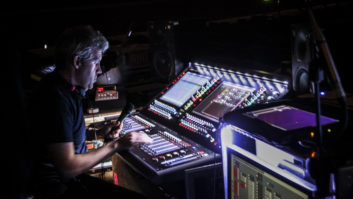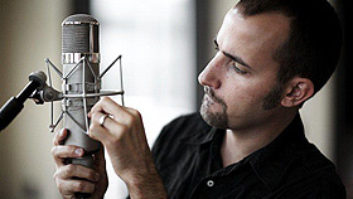Last month, I was describing a video project from Hell: a short documentary film that I was producing and writing that should have taken six weeks, but was soon entering its fourth month. Thanks to the quirks and bugs in a video editing program called EditDV, my co-producer and academic colleague, Howard Woolf, and his three student editors were tearing their hair out trying to get the thing done, while I sat on the sidelines and thought about the bad old days of the first music and audio software — which I was now living again.
If you forgot (or never read) the first part, then do go back and read it now, because the background will be helpful. If you don’t have the print magazine handy, then look for the article on www.mixonline.com.
Before we proceed, some definitions of acronyms: DV stands for Digital Video. ASA stands for the Acoustical Society of America, the folks who had commissioned the film in the first place. AES stands for the Audio Engineering Society, the group, not the convention.
When we last left our intrepid heroes, they (that is, we) had, after much pain, sent off a DV copy of the film to the ASA, which was planning to show it two days later at their annual convention in Southern California. The night after we shipped it, I looked at a VHS dub Howard had made for me and discovered, to my horror, that there was visual timecode prominently printed on it. Because we had no way of knowing whether the DV tape we sent had the SMPTE numbers burned in, we made another DV dub the next morning and sent it out FedEx Same Day Delivery, so it would get there by nightfall, in time for the next morning’s convention session. Now, let’s pick up the story…
The next day, I came home to a lovely message on my answering machine from the chairman of the panel at the ASA meeting, thanking me for the film. There was also a message from a friend at Yamaha, whom I had dragooned into introducing the film, assuring me that the timecode numbers were nowhere to be seen on either DV tape we had sent. So, for a change, something had come out right.
But the film was still very much unfinished. Most of the effects and cool transitions that Howard wanted to put into it weren’t there, a lot of the stills still had “vibrating” problems and the audio tracks were a mess: levels all over the place, channels switching at random, and big silent holes in the narration where there should have been room sound. Perhaps we should have cut our losses and stopped right there, but then I got another bite: The local chapter of the AES wanted to screen the film, too, at their annual banquet. Never one to pass up an opportunity to promote a project (or get a free meal), I accepted the invitation.
Now we had another deadline. Fortunately, it was five months away, and Howard was confident that the problems could be fixed. I made a special vow to clean up the sound — this was, after all, the AES, and I really didn’t want to be horribly embarrassed, especially because this time I was going to be there in person.
What made Howard particularly sanguine was that there was now finally a 3.0 Version of EditDV, which he was sure would took care of the earlier version’s limitations and bugs. Media100, the company that was now making the software (having bought up Digital Origin, which was a reincarnation of Radius), claimed that they had broken the 2-gigabyte, 9-minute barrier that had encumbered previous DV editing programs: In Windows’ native format, you can’t address a file larger than 2 gigabytes. “This was geared to the music market,” Howard told me, “especially concert shooting.” Panning and zooming of stills — the “Ken Burns effect” — was now built into the program so that you didn’t have to export files to a compositing program like AfterEffects to do those types of tricks. There was a History feature, like Photoshop’s, that allowed you to go back and undo multiple layers of edits. And you could work on several versions of a program simultaneously using a new Composition feature; previously, you had to have multiple iterations of the software running to do that, which was, according to Howard, “an invitation to crash. One student lost all of his files that way.”
For my part, I had some doubts. Media100 had renamed the program Cinestream. Why? Because it had new features that were oriented toward the Web: You could insert a Web link into a video, which would allow you to, say, click on the cool jacket a character in a streaming cartoon was wearing and order it on the spot from Walmart. This wasn’t exactly something the mainstream video market was screaming for. “Video producers were very upset that they might no longer be able to output to tape,” Howard told me, “but the company assured them that wouldn’t change.” Also, word had gotten around that two of the top engineers at Media100 had left for greener pastures at Adobe to work on Premiere 6. It was true: After that program came out, Howard said, “You could see their fingerprints all over it.”
But Howard went ahead and moved his EditDV files into Cinestream and started to work on them, in the hopes of creating a smooth, new version for the AES banquet. We also planned a showing at a student film festival at Tufts University (which, you may recall, paid for it, because the ASA didn’t give us any money) a few weeks before the AES banquet, at the beginning of May. In addition to cleaning up the film, Howard wanted to try a new approach: He wanted to take out my on-camera narration (we both agreed I looked terrible) and hire an actor to read parts of my narration, and then fill in some of the information by interviewing me on camera. We shot the interview in about three hours in his living room (it looked fine), and he recorded the narration in an evening.
All seemed well until the end of April, as we started to get close to the date of the banquet. I was busy wrapping up my classes for the year and preparing for a bunch of performances, so I wasn’t paying much attention to the fact that I hadn’t heard anything from Howard about viewing a rough cut, or helping him with the audio. I called him from time to time, and he was always noncommittal, telling me he was “working on it.”
Howard’s a great guy, but at this point, I should have noticed an odd smell emitting from the phone whenever I spoke to him. The evening of the Tufts showing arrived, and I still had not seen his cut. (This will sound familiar if you were paying attention last month.) There were about 60 people crammed into the lecture hall where we were going to show it — but no Howard. Finally, he came in and, offering a vague apology for being late, put a tape into the projector. To my great surprise, what I saw was essentially the same film I had seen back in December, the major difference being that about 10 minutes of footage, which had been taken out to meet the ASA convention’s time limit, had been restored. I was still the narrator, I still looked awful, there were still editing problems and vibrating stills, and the audio still sucked.
What had happened to Howard’s new cut? Once again, the software screwed us. This time, it wasn’t a spectacular crash like last time. This time, it was the simple fact that the bright, shining new version of the software didn’t work.
Media100, in its haste to get the product out the door before the competition (Adobe) got Premiere 6 out, had screwed up, and worse, had lied about it. “The nine-minute thing didn’t happen,” Howard told me a few days later. In fact, as of this writing, it still hasn’t happened. “The pan-and-zoom feature looks terrible. It puts these rolling horizontal or diagonal lines into the picture that look like analog tape dropout. The company at least put a disclaimer into the box about not implementing the nine-minute feature, but they didn’t say anything about the problem with pan-and-zoom.”
There was more, much more: “Whenever you close the program, you get an error message, because it’s not clearing itself completely out of memory. Sometimes the computer hangs, and if it doesn’t, then when you relaunch the program, it crashes. But this only happens if you’re hooked up to a video deck.” Presumably, the developers never tested it that way.
“The History feature is inconsistent, and it’s hard to figure out what’s remembered and undo-able, and what’s not,” he continued. There’s a Video Dissolve function, but it gives you no control over pre- and post-fade times: “If there is a hard cut in the original program material, and the pre-programmed fade time happens to overlap the cut, you get ghost frames from what’s on the other side of the cut.” That’s why there were all those weird flash frames and jumpy edits. “The only way to do controlled dissolves is to double-process the tracks. It’s like going twice around the block to get next door.” But this wasn’t a bug; it was a feature. “It’s an idiot-proofing device designed to make it easier for people who don’t really understand what’s going on when they create a dissolve. So it’s been in EditDV from the start, and it didn’t change in the new version. I guess they figured everyone was used to it or had developed work-arounds.”
Howard also showed me why he couldn’t get the audio to cooperate. Any kind of processing applied to a clip, whether it’s video or audio, is called “filtering.” Audio processes, like stereo placement and gain change, are grouped incongruously with video dissolves, fades and wipes. But the audio filtering is all “offline”: To use any of the features, you first have to manually create an “fx” track, which the processed audio gets laid onto, then set your parameters (with no aural feedback, not even Premiere’s clunky Preview feature), apply the process (called “rendering”) and then listen to it — and hope you did it right. “It’s totally hit or miss,” according to Howard.
There are graphical tools like level meters for audio, but they are, for the most part, useless. “If you go for a consistent level on the meters, the result is that the levels are all over the place,” he said. There is rubber-band editing for audio levels, but besides the fact that the visual display is tiny, there is that long pause for the audio to render before you can hear what you’ve done, which takes all of the intuitiveness out of it. And there is audio waveform drawing, but it is, according to Howard, “ridiculously slow. I tell my students never to use it. And it’s not interruptible once you start. Unfortunately, the tiny arrow that tells the program to draw the waveform is right next to the tiny arrow that lets you visually collapse tracks — and if you hit the wrong one, you might as well go out for lunch.”
Synchronization issues that had been in EditDV 2.0 still hadn’t been worked out. “Out of nowhere, the sync goes away,” he explained. “You often have to slide audio tracks around by trial and error. Deleted parts of the track still have some kind of data in them, and that knocks the sync off. The program would be telling us that the video and audio were 18 frames off, but they’d play in perfect sync. There’s no way that DV itself can go out of sync, since everything’s recorded in the same datastream, so they’re doing something wrong with the data. There’s also a problem when you’re playing the audio through a soundcard — there’s latency. The company insisted it was a glitch in QuickTime, but then they put out a patch that advances the playback audio by eight frames.”
One of the worst aspects of the new program, and the one that was causing Howard’s already fragile hairline to move back even further, was that in the middle of an edit session, the filtering functions — both audio and video — would just stop working. “Any time you render any track and then do something else to the track, the program will just ignore you. It won’t do anything at all.” There was no information available from the manufacturer’s tech support about this, so it was up to an online user group to spread the word of a work-around: “Before you render anything, you have to first cut all tracks that have effects on them and paste them back in. Then you can re-render. That’s really scary!”
But the absolute worst “feature,” the one that should have the programmers and marketers deported to a remote desert island where their modems will only work at 300 baud and their power will go off at random times during the day (wait a minute, that sounds like California!) is this: Files created, or even just opened, in Cinestream could not be opened in EditDV 2.0. “The company didn’t tell anyone that files were not backward-compatible,” Howard sighed. “Once you opened up a video program, even if you haven’t touched it, you can’t open it again in EditDV. If you didn’t like it, you were stuck with it. So once we started working with the new software, there was no turning back, as much as we might have wanted to.
“It’s been one heart attack after another,” Howard continued. “You should see what people are saying on the user group bulletin board.” As to why he hadn’t shown me a rough cut, it was because he didn’t have one. And he feared that if he told me he was making so little progress, I would have bitten his head off.
By the time the AES banquet rolled around nearly a month later, Howard was able to clean up some of the jumpy edits, but the stills were still shaking. He was able to implement some of my suggestions about the audio, so it was not quite so egregiously bad, but I was still a long way from happy with it. To my great embarrassment, two different gentlemen at the banquet approached me after the screening and whispered, “I could help you with the sound mix.”
As I write, three months later, I have still never seen Howard’s new cut or any of the interview footage we shot in his living room incorporated into the film. He has abandoned Cinestream, and is slowly but surely moving the original files onto a new, faster disk and converting them from QuickTime to Windows AVI format. His plan is to reassemble the program in Premiere 6.0.1, with the help of a new video card, the DVStorm made by Canopus. “I just finished a little project with it, and it’s wonderful,” he says. “I don’t want to give Premiere too much credit, because what makes it stable are the plug-ins and drivers that Canopus has written for their hardware. It doesn’t crash; it just works. It renders on-the-fly, so you can see what you’re doing in real time. And it handles sound much more nicely.” The only thing slowing down the process is that he has to convert the files one at a time — there are no batch converters that can do what he needs to do.
Another friend of mine, also a video editor, when I told him this story, replied, “Why did you go with EditDV? Everybody knows it’s dead.” Yeah, but unfortunately we didn’t know that when we started.
So I’ve been through the wringer on this project, and it’s not over. Hopefully by abandoning the platform that once seemed so promising, Howard and I can put all these problems behind us and finish the film, and then go on to the next step: convincing someone to give us money to do a 60-minute version and sell it to the broadcast market. We think the film is that interesting, and the quality, with our $1,000 camera, is no doubt up to broadcast standards.
But besides the fact that it made my life miserable for the past year, why should you care about my trials? Because I fear they soon may be yours.
Mini-DV, perhaps the first true “prosumer” video format, is selling in enormous numbers. It’s forcing down the prices not only of cameras and decks, but also of the ancillary tools like video cards and editing software; in the case of Apple’s iMovie, the price has gone down to zero. As with any technology that suddenly finds a mass market, competition is vicious, margins are shrinking and development cycles are tightening. The need to sell large volumes of product, as fast as possible, is overtaking the need to make a reliable product.
When less-than-functional software gets into the marketplace, the users end up holding the bag. Magazine reviews are of little help — searching the Web and my stock of print magazines, I was unable to find a single negative review of either EditDV or Cinestream. This is not surprising, because reviewers don’t have nearly enough time to evaluate products in any depth or do serious bug-hunting, and lead times in the publishing world (even on the Internet) are such that by the time a review appears, the next version of the product has been released — with an all-new set of features and bugs.
In the professional world, audio has too often played second fiddle to video, and as the atrocious audio features in Cinestream show, it’s even worse in the prosumer field. Is this good news for audio professionals? In some ways, it is, in that we can expect that more people will be coming to us to bail them out of their audio problems. But that’s a mixed blessing: They’re not going to be willing to pay $250 an hour, or even $100, to save their audio when they can download Pro Tools Free for nothing. So we can look forward to another round of “micro-project” studios cropping up, containing little more than a laptop with an extra monitor, a cheap tube mic and a pair of “multimedia” speakers, whose owners will advertise that they can clean up the audio on video projects, add narration (by a hungry, out-of-work actor), add sound effects (downloaded) and lay in music (generated from Acid loops), all for $250 — not per studio hour, but per program hour.
There’s always a lot of pressure on tool developers to be the firstest with the mostest. But when the pro world and consumer worlds merge, that pressure gets insane. More flashy features, whether users really need them or not, and whether they work or not, take priority over reliability. Development cycles go into negative time-space, and testing sinks even further down the priority list. And there are few survivors in the world of consumer electronics: In pro audio, ADAT and TDIF have been able to co-exist well, but compare that to the battle between VHS and Betamax.
The audio and video worlds are likewise merging: More and more developers are working in both areas, and video companies are absorbing or licensing technology from audio companies. So the pressure brought on by trying to dominate the consumer market may very well infect the companies that make our tools as well. If they do, we’ll be back where we started, in those bad old days of crummy, slow, crash-laden, file-format-incompatible audio programs.
I, for one, am not looking forward to it.
Paul D. Lehrman is Mix‘s Web editor. You can see more about the project he’s talking about atwww.antheil.org.





